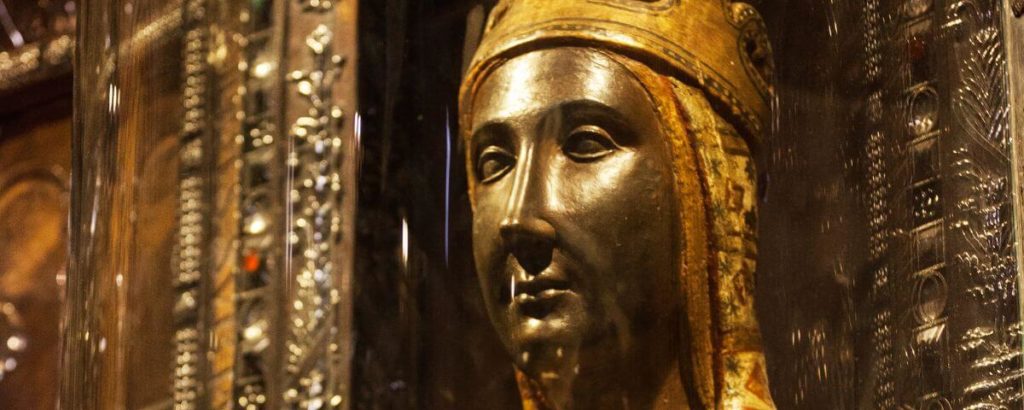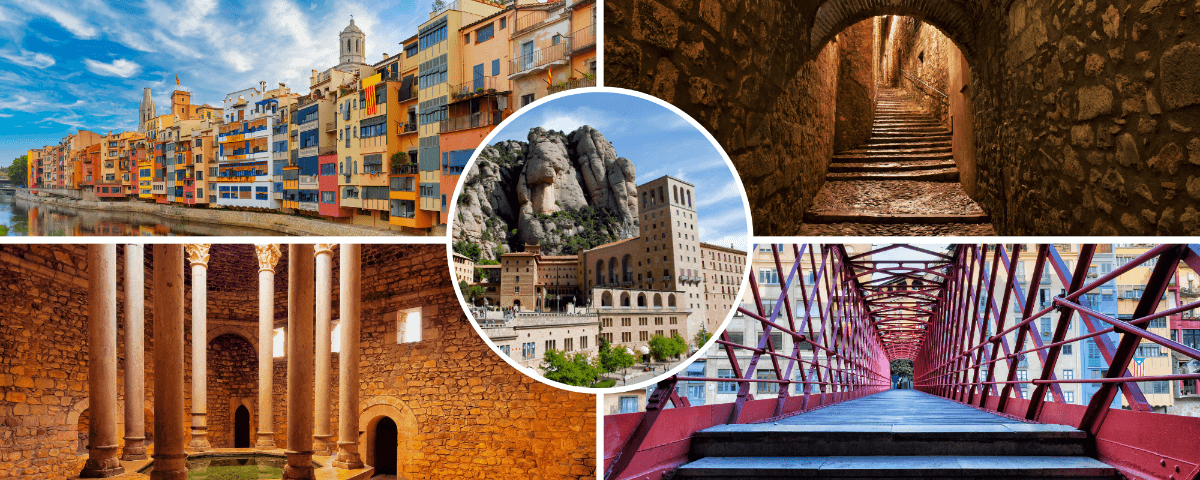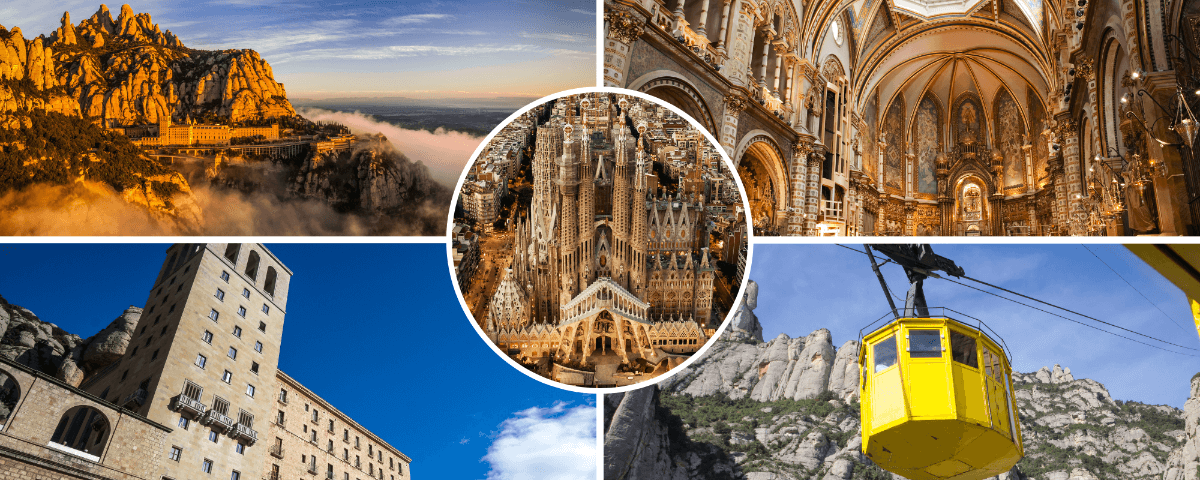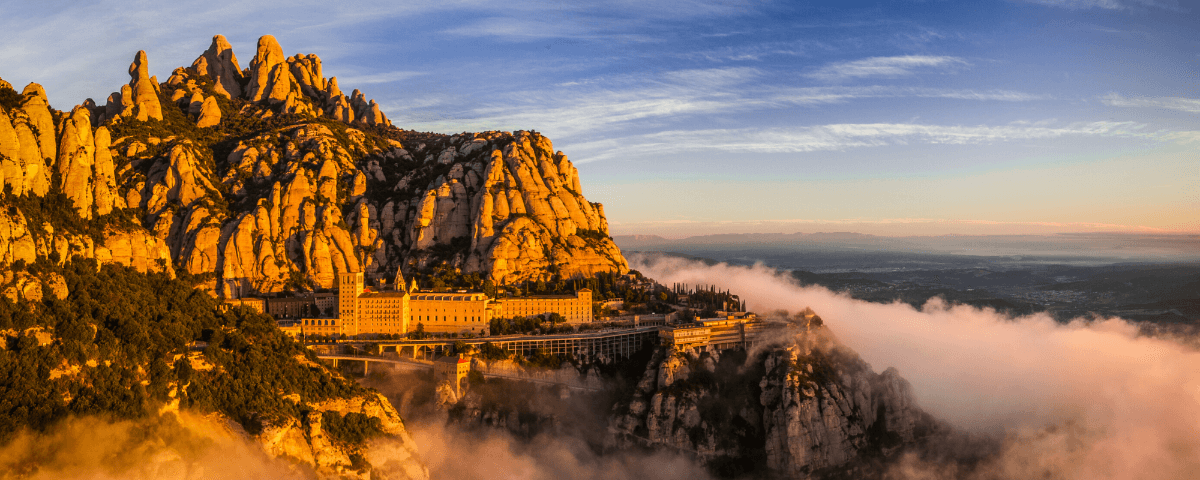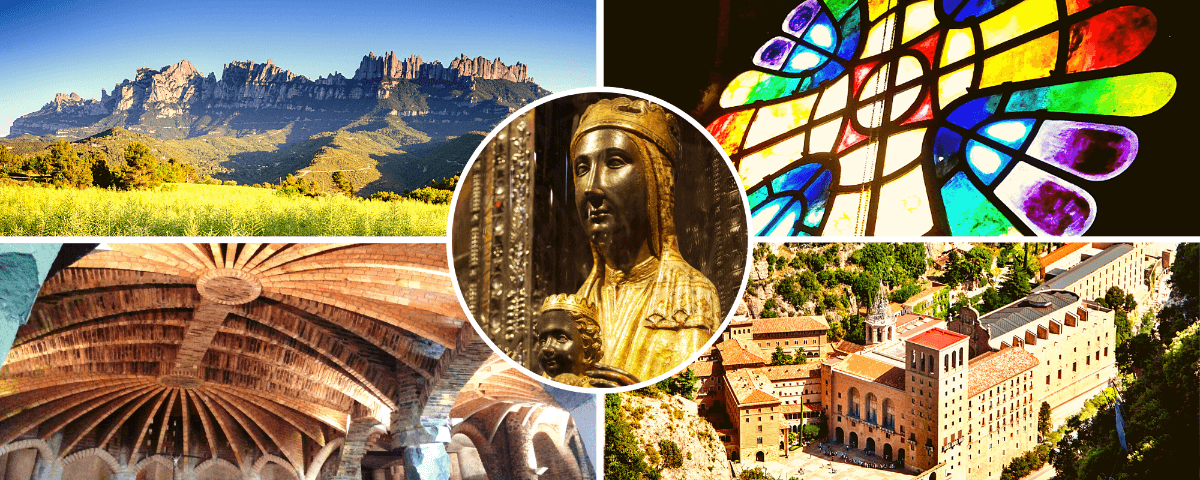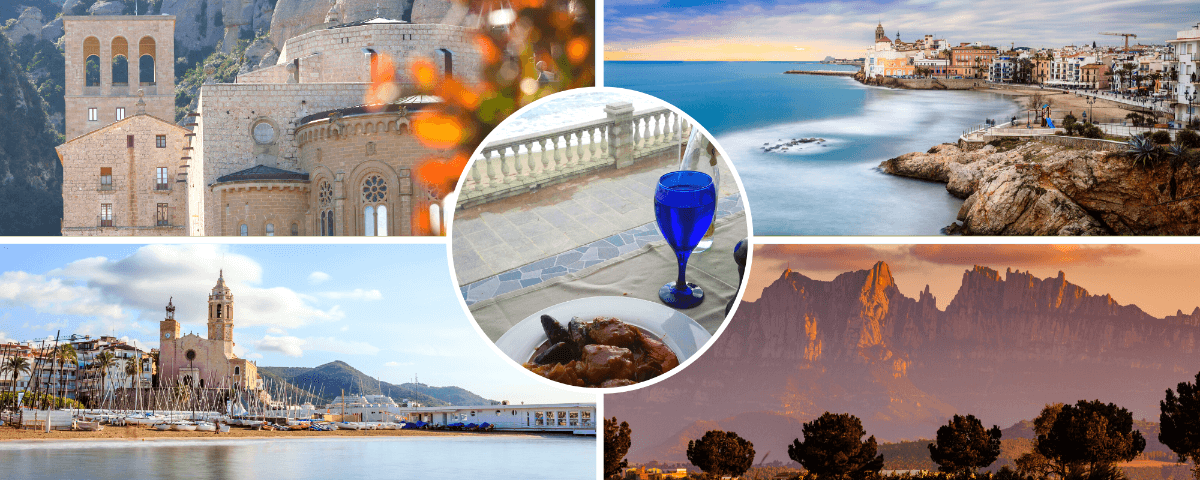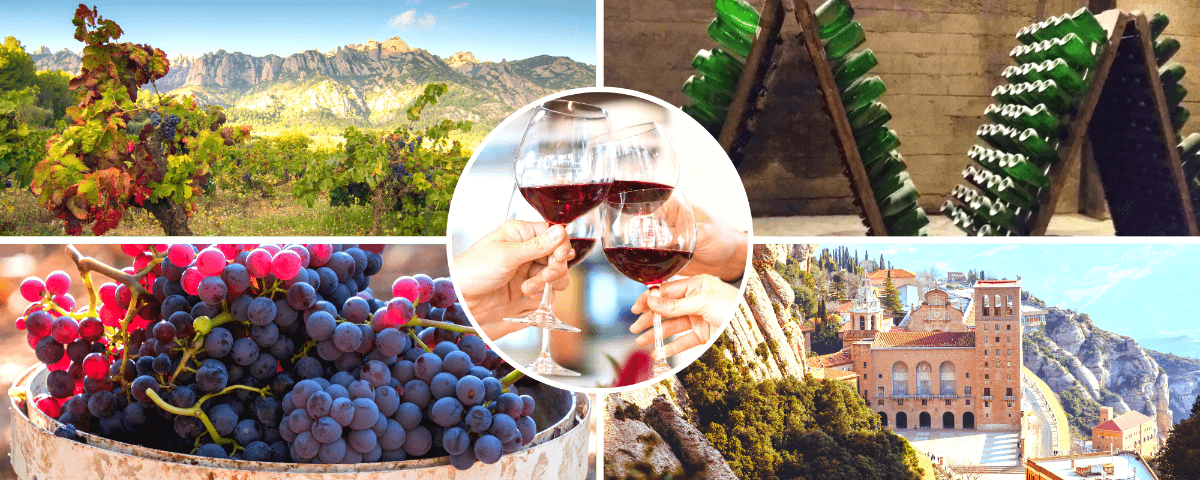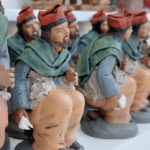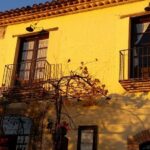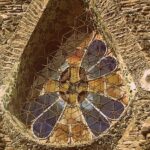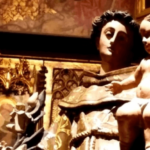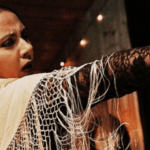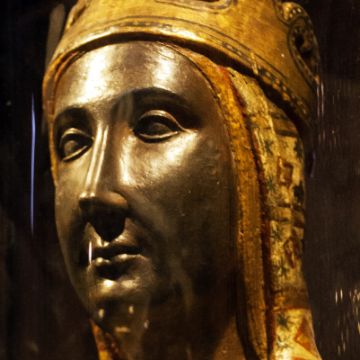
Who is the Black Madonna Our Lady of Montserrat?
EVERYTHING ABOUT THE MONTSERRAT VIRGIN
Montserrat, from “Mont” (mount) and “serrat” (serrated). The name applies to a rocky mountain located less than 1 hour drive from Barcelona (Spain), whose shape made locals think it had been the angels that serrated the mountain with golden saws. And it also applies to the Black Madonna found in the mountain by miracle in the 800’s.
Her story and influence has always fascinated me, and I never get tired of taking people on a tour to admire Her. Her serene face brings me inner peace, and it also reminds me of my late grandparents, who were very devoted and came to the monastery in their honey moon back in the mid 1900’s, when it was a trip, not just a quick ride. Today I want to share with you my view about the famous Black Madonna of Montserrat and everything you need to know about her. Enjoy!
Our Lady of Montserrat Miracles & History
1
Origins that get lost in the mist of time
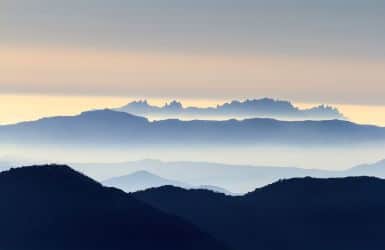
The fascinating shapes of the Montserrat Mountain have inspired spirituality for centuries. Some sources indicate that in the Roman times (197DC, according to some), there was already a Roman temple dedicated to Venus, Goddess of beauty, love and fertility.
And the Virgin Mary is historically seen as a (purer) equivalent of such deity. Interestingly enough, the temple would have been located where now stands the Chapel of Saint Michael, less than 30 minutes walk from the monastery, and not many feet above the location of the Holy Cave, where Our Lady of Montserrat was found.
As for the statue, some believe Jesus himself asked Saint Luc to carve a sculpture with the portrait of the Virgin Mary, and that she lent him the carpentry tools she still kept at home. Years later, Saint Paul arrived to Barcelona on a boat, carrying that sculpture with him, which he gifted to the local Christian community. Because it arrived from Jerusalem, people called her the “Jerusalemite”.
In 718 Barcelona was attacked by the moors, and the Christians decided to evacuate the sculpture and hide it in a cave in the mountain of Montserrat. But since the moors controlled Barcelona for the next 80 years, the exact location of the image was eventually forgotten.
2
The legend of how she was found by miracle
The story goes that one night, in 880, a group of young shepherds saw light coming out of a cave in the mountain. There was also music playing. When they approached it, they saw a sculpture of the Virgin Mary surrounded by angels playing instruments and signing.
They decided to run to the Bishop, the highest authority – sources don’t agree if it was the Bishop of Manresa or the one of Barcelona – but Manresa is much closer. Maybe they first alerted their parents in the village or the local priest, and they also saw Her and urged them to tell the Bishop.
Anyway the Bishop went to the cave with them and decided to take the sculpture to town so she could be properly worshipped in the Cathedral. But as they started carrying her down another miracle happened: she started becoming heavier and heavier, so in the end nobody was able to lift her up anymore. That’s when the Bishop understood the message: She wanted to stay in the mountain.
3
Brief history of the Montserrat Monastery
By the 1100’s it had won the range of Abbey, and pilgrims started arriving attracted by the stories about the miracles that led to Her discovery. In the 1200’s there’s already a boys choir, the Escolania, permanently based in the monastery to sing to Our Lady of Montserrat daily.
The end of the 1400’s brings the construction of the Gothic cloister and the arrival of one of the first printers in Spain. Bernat Boïl, one of the hermits, joins Christopher Columbus in this second trip and names one of the Caribbean Isles where they stop after the Madonna of Montserrat.
Unfortunately, during the Napoleonic Wars (1811-12) the monastery was attacked and seriously damaged. As a result, most of the buildings visited nowadays belong to the reconstruction from the early 1800’s.
The Image of the Montserrat Black Madonna
4
The statue of Our Lady
Following the Romanesque tradition, the Mother of Jesus is presented in a static way with the Child on her lap – more a throne for the Savior than a loving mother. She measures 95cm / 3.1 ft. and is made out of poplar wood. Her skin is dark and her clothes golden.
She holds a sphere on her right hand, which has been interpreted as the universe – a symbol of power. The child holds instead a pine cone – symbol of eternal life (pine trees are evergreen).
5
"La Moreneta", or why is She a Black Madonna?
What recent restoration works suggest is that at first the smoke of the candles surrounding the image started sooting it. And maybe the paint and varnish covering it rusted, too, darkening its surface. Until around the 1500’s it was painted in a light brown color, probably thinking they were returning it to its original color.
Another layer of paint dating from the 1800’s was added in a dark brown color. By then the locals had already given her the sweet nickname of “La Moreneta”, the little sun-tanned girl. For them it would have been a shock to have been cleaned back to a whiter color. And that’s how she got to our times being a Black Virgin, and she’ll continue to be.
Venerating the Black Virgin of Montserrat
6
The Montserrat Virgin for Spain and Catalonia
The Black Madonnna of Montserrat is one of the 51 Black Virgins in Spain, and hierarchically probably the second most important. The Virgen del Pilar from Zaragoza and the Virgen de Guadalupe from Extremadura are also Black Madonnas, and they rival for the title of female patron saints of Spain.
The Montserrat Black Madonna is however, the patron saint of Catalonia – declared so by Pope Leo XIII in 1881. Catalan celebrate her day on April 27th. Montserrat is a very common given name for ladies, and they are often called Montse, Muntse or Mon for short.
7
The Virolai Anthem
The Virolai is the anthem of Our Lady of Montserrat. Many Catalans call the song “Rosa d’Abril” (April Rose), because that’s the start of its first line. The words were written by the poet and priest Jacint Verdaguer and sang for the first time in 1880 during the celebration of the 1000 anniversary of the monastery of Montserrat.
The music was composed by Josep Rodoreda. You can hear the Escolania Choir perform it every day at 1PM in the Royal Basilica of Montserrat (except Sunday, when it’s sung at noon right after mass is over).
8
Historical characters that prayed to the Montserrat Black Madonna
The most famous Saint to have worshipped the Black Virgin of Montserrat is Saint Ignatius of Loyola. He is said to have prayed there for 3 days, then revealed to his confessor at the Monastery that he had the intention to abandon his military career and offered her sword to the Black Madonna.
Other minor local Saints such as Saint Peter Nolasco, Saint Vincent Ferrer, St. Joseph Calasanctius and Saint Antony Mary Claret. Also St. Francis Borgia, nephew of the famous Lucrezia Borgia and grandson of Pope Alexander VI (Rodrigo Borgia). And more recently, Pope John XXIII visited when he was still a cardinal, and Jean Paul II visited in 1982.
European royals were also devoted to Her. Both Emperor Charles V and King Philip II of Spain died holding blessed candles from the Montserrat Monastery. King Louis XIV of France paid the Montserrat monks so they’d pray for his mother. And also the Emperor Ferdinand III of Austria made generous donations, too.
Visiting the Black Madonna at Montserrat
9
The Holy Cave
A paved path that often involves steps takes you there from the Monastery in some 45 minutes walk. You can, though spare 10 minutes walk or so by taking the Funicular de la Santa Cova. It doesn’t sound like a big saving, but it’s the steepest part and it’s a great idea for the way back, when it’s uphill.
The path is adorned with sculptures of the Sorrowful Mysteries of the Passion of Jesus. A young Antoni Gaudí participated in the creation of the first mystery of the Glory. While it’s hard to track his imprint, a Catalan flag made of broken mosaic tile pieces gives you a hint.
The Chapel of the Holy Cave is only open until the late afternoon and the access is free of charge. Inside you can appreciate that the wall behind the altar is not man-made, but the actual rock of the mountain. It sort of looks like a a small rock shelter, but it might be disappointing to see that’s not really an actual “cave”. The image of the Black Madonna is also a smaller copy.
10
Her Shrine in the Basilica
A path connecting the side chapels of the right aisle of the Basilica leads to a staircase decorated with a golden mosaic representing Virgin and Mother Christian saints. Then after going through a small hall displaying some religious artifacts you go up some more steps before crossing the silver doors of the Black Madonna shrine (known as “cambril”).
The tradition is touching or kissing the sphere on the hand of the Montserrat Virgin and making a wish. You can also say a short prayer and take a quick picture of the Basilica and its rose window from the balcony, before letting the next people in line take your spot.
As you exit, you’ll see a small circular chapel surrounded by stained glass windows. It is often used for weddings and to offer you the opportunity of longer prayers. From there, above the altar, you see the Black Madonna from behind.
The exit is done via the Camí de l’Ave Maria, a path between the Basilica wall and the mountain rocks, decorated with ceramic plates and the words of the Virgin Mary Litany. There’s also candles lit by the pilgrims for Her.
11
How to get to Montserrat from Barcelona
- BY CAR. There’s two main roads taking you to Montserrat and both take about the same amount of time (about 1 hour). There’s the C-58 that goes through the Valles county, then joins the C-55 to Monistrol de Montserrat at the foot of the mountain, then on to the Monastery. Then there’s the A2 that follows the Llobregat river. Upon reaching Abrera you can take the local road BV1201 to reach the monastery from the Monistrol side, or continue along the mountain to El Bruch, and take the B111.
- BY TRAIN. The R5 is a suburban line that departs from Plaça Espanya and has two stops in Montserrat. The first one is the Aeri de Montserrat, where you switch to a cable car that takes you to the monastery. The next one is Monistrol de Montserrat, where you switch to the rack train going up the mountain to the monastery, too. If you are planning to take the train, consider purchasing this pass – it’s a very good deal!
- BY BUS. There’s only one public bus heading to Montserrat every morning at 9.15 from the Bus Station of Sants Estacio. Then it heads back to Barcelona in the late afternoon (5PM or 6PM, depending on the season).
- BY TAXI. It’s a strange option to go to Montserrat from Barcelona by taxi, but you’ll make the driver’s day because he’ll make good money. But it can be an option to go back if you miss the last bus or train. By the Information Point of Montserrat you’ll find a list of taxi phone numbers that can come pick you up at the monastery and take you back to the city.
- GROUP BUS TOUR. There’s also several companies that organize big bus tours and small group tours to Montserrat. In most of them there’s a tour guide that gives explanations during the rides and gives you a quick tour before giving you free time until it’s time to get back. So you are mostly on your own.
- PRIVATE TOUR. This is a tour where you have your own tour guide with you at all times. You get explanations on the way there, you get the highlights tour, but then there’s also some time to do other things of your interest. And your guide will be with you to give you more explanations and help with logistics: which way to go, how long it’ll take, getting tickets in advance, and so on. You get your own personal experience that you don’t share with strangers.
12
Private Tours from Barcelona to Montserrat
At ForeverBarcelona we provide a variety of private tours to Montserrat, some of them combining Montserrat with one more destination. Let me share them with you, for your inspiration:
- Montserrat Half Day Tour. 5 or 6 hours. We take you to the Montserrat Monastery and you get to see the Montserrat Black Virgin Mary and everything else you want.
- Day trip from Barcelona to Montserrat. 8 hours. Like the half day tour, but we stay for lunch in a countryside restaurant at the foot of the mountain.
- Montserrat and Sitges tour. 8 hours. Morning in Montserrat and lunch by the sea in the town of Sitges.
- Montserrat and wine tour from Barcelona. Early visit of Montserrat, wine cellar visit and lunch in the wine country.
- Montserrat & Colonia Guell tour. 8 hours. Stop in Colonia Guell to see the other unfinished church by Gaudi, then continue to Montserrat for a visit and lunch in a countryside restaurant.
- Montserrat & Barcelona tour. 9 hours. Morning in Montserrat, then head back to Barcelona for a tapas lunch and a city tour.
- Montserrat and Girona tour. 10 hours. Morning in Montserrat and afternoon in Girona. And ambitious and long day for those who want it all.
Are you devoted to the Black Madonna of Montserrat?
Marta
MORE BARCELONA TIPS FOR YOU:
SHARE WITH YOUR TRAVEL MATES
RESEARCHING FOR A TRIP IS TIME-CONSUMING…
Need more inspiration?
Our 100% FREE Barcelona Collection will give you everything you need to organize the trip of your lifetime to Barcelona.
BEST INSIDER TIPS FROM THE PROS!

Last update on 2024-04-24 / Affiliate links / Images from Amazon Product Advertising API

